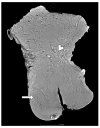Three-Dimensional Microscopic Characteristics of the Human Uterine Cervix Evaluated by Microtomography
- PMID: 40075850
- PMCID: PMC11898730
- DOI: 10.3390/diagnostics15050603
Three-Dimensional Microscopic Characteristics of the Human Uterine Cervix Evaluated by Microtomography
Abstract
Objectives: To analyze the microscopic anatomy of the human uterine cervix in two-dimensional (2D) and three-dimensional (3D) images obtained by microtomography (microCT). Methods: Human uterine cervixes surgically removed for benign gynecologic conditions were immersed in formalin and iodine solution for more than 72 h and images were acquired by microtomography. Results: In total, 10 cervical specimens were evaluated. The images provided by microCT allowed the study of the vaginal squamous epithelium, demonstrated microscopic 3D images of the metaplastic process between the exo and endocervix, and demonstrated the effects of metaplastic transformation on the thickness of the endocervical epithelium. Also reconstructed in 3D the endocervical folds and the repercussions of the metaplastic process on the endocervix, the changes of the endocervical epithelium along the cervical lumen and the relationship between the endocervix epithelium from the internal os and endometrium. In addition, 2D images could demonstrate the difference in tissue orientation of the collagen on the cervical stroma in a large field of view. Conclusions: MicroCT could demonstrate the microscopic anatomy of the human uterine cervix in 2D and 3D images, including the different stages of metaplastic process of the endocervical epithelium and reconstructed the endocervical lumen in 3D, preserving its natural anatomy without any mechanical effect for its dilatation.
Keywords: microscopy; microtomography; three-dimensional image; two-dimensional image; uterine cervix.
Conflict of interest statement
The authors report no conflicts of interest.
Figures










References
-
- Temkin O., Eastman N.J., Edelstein L., Guttmacher A.F., translators. Soranus’ Gynecology. Johns Hopkins University Press; Baltimore, MD, USA: 1956. [(accessed on 24 September 2024)]. Available online: https://books.google.com.br/books?redir_esc=y&hl=pt-BR&id=YsKWfh31gxwC&q....
-
- Ahmed A.I., Aldhaheri S.R., Rodriguez-Kovacs J., Narasimhulu D., Putra M., Minkoff H., Haberman S. Sonographic Measurement of Cervical Volume in Pregnant Women at High Risk of Preterm Birth Using a Geometric Formula for a Frustum Versus 3-Dimensional Automated Virtual Organ Computer-Aided Analysis. J. Ultrasound Med. 2017;36:2209–2217. doi: 10.1002/jum.14253. - DOI - PubMed
-
- Peters R., Castro P.T., Matos A.P.P., Ribeiro G., Lopes Dos Santos J., Araujo Júnior E., Werner H. Virtual segmentation of three-dimensional ultrasound images of morphological structures of an ex vivo ectopic pregnancy inside a fallopian tube. J. Clin. Ultrasound. 2022;50:535–539. doi: 10.1002/jcu.23193. - DOI - PubMed
-
- WHO Cancer Fact Sheet No. 297. 2015. [(accessed on 23 September 2024)]. Available online: http://www.who.int/mediacentre/factsheets/fs297/en/
LinkOut - more resources
Full Text Sources

